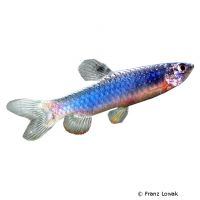Redspotted Tetra (Copeina guttata)
| Redspotted Tetra Copeina guttata | |
|---|---|
| Name | Redspotted Tetra |
| Name Lat. | Copeina guttata |
| Synonym | Pyrrhulina guttata |
| Family | Pencilfishes |
| Family lat. | Lebiasinidae |
| Order | Characins |
| Order lat. | Characiformes |
| Origin | South America |
| Habitat | Streams, rivers, ponds |
| Diet | Carnivore |
| pH | 4.0-7.5 |
| Behavior | Peaceful |
| Keeping | Group |
| Care Level | Moderate |
| Reproduction | Substrate spawner |
| Breeding | Moderately difficult |
| Life Span | 3-5 years |
| Protection | No |
| Metric Units | |
| Size | 6-8 cm |
| Temperature | 23-28 °C |
| Hardness | 1-10 °dH |
| Aquarium | 80 cm / 110 l |
| US Units | |
| Size | 2.4"-3.1" |
| Temperature | 73-82 °F |
| Hardness | 18-178 ppm |
| Aquarium | 30 gal |
Distribution and habitat
Trout tetras are widespread in the Central Amazon watershed. They live in slow-flowing, small rivers and streams as well as in stagnant waters, such as ponds and floodplains with dense vegetation.
Maintenance
The aquarium should have soft, slightly acidic water and varied planting that provides both shelter and swimming space. A dark substrate and shaded light (floating plant cover) is ideal.
No ammonia, ammonium or nitrite should be detectable, and the nitrate value should not exceed 100 mg/l. To ensure the water quality and oxygen content, a filter and heater adapted to the aquarium size is required, as well as lighting for the species-appropriate day-night rhythm of the animals.
Diet
In the wild they feed mainly on worms, insects and small crustaceans. The food supply consists of live food, such as cyclops, daphnia, artemia and mosquito larvae, which are also well accepted frozen, plus commercially available frozen special food mixtures. High-quality, protein-rich dry food (flakes, granules) is also usually accepted without problems.
A regular and varied diet promotes health and prevents deficiency symptoms. Only as much should be fed as is eaten immediately (in a maximum of 10 minutes).
Behaviour and compatibility
They are peaceful schooling fish that can be socialized with other, even larger fish without any problems. At least 5, but preferably more trout tetras should be kept together, whereby the number of females should predominate.
In principle, only mutually compatible fish species with similar requirements for water conditions and water temperature may be socialized.
Sex dimorphism
The males have elongated fins and are more intensely colored in the front part of the body. The females are paler and have much smaller fins.
Reproduction and breeding
Trout tetras lay their eggs in a sand pit fanned out by the male. The male also takes care of the brood. After 30-50 hours the larvae hatch and swim free after about 8 days
Fry must be fed several times a day with special rearing food (dust food). In community tanks breeding is hardly possible, because the spawn is easy prey.
Important
The well-being of the fish should be checked regularly. The temperature should be checked daily, the pH, hardness and nitrate value at least every 14 days. A regular partial water change is recommended, even if the pollutant load has not yet reached the upper limit. Sudden changes in water quality should be avoided. Newly introduced fish must be accustomed slowly to the water in the aquarium.
Further literature can be found in your pet store.
References
Text: Sabina Lamboj; Image: Franz Lowak
Source: BMELV (1998): Tierschutzgutachten - Haltung von Zierfischen (Süßwasser); RIEHL & BAENSCH (2006): Aquarien Atlas Bd. 1, Mergus Verlag; ENGELMANN (2005): Zootierhaltung - Tiere in menschlicher Obhut: Fische, Verlag Harri Deutsch
- Gemäß § 21 Abs. 5 Tierschutzgesetz idgF
